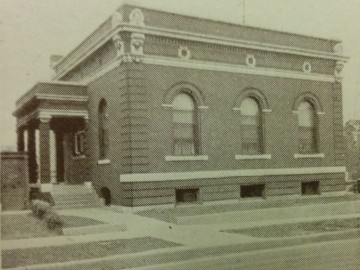 The building located at 2201 Indiana Avenue, nicknamed the “Victor” exchange, was the third telephone exchange built by the Kinloch Telephone Company. Construction of the branch was approved in 1903, and the building was completed in 1904 at a cost of roughly $25,000. The switchboard, with a capacity of 7,200 lines, was cut into service that same year.
The building located at 2201 Indiana Avenue, nicknamed the “Victor” exchange, was the third telephone exchange built by the Kinloch Telephone Company. Construction of the branch was approved in 1903, and the building was completed in 1904 at a cost of roughly $25,000. The switchboard, with a capacity of 7,200 lines, was cut into service that same year.
This 10,000 square foot building was built of “fire proof” construction, utilizing brick as its primary material. The McKinley Heights neighborhood exhibited a lot of growth in those years, as indicated by the maps below. While Compton & Dry’s Pictorial St. Louis in 1875 shows very few buildings near the intersection of Indiana and Ann (Ann Avenue does not even appear to be a working street yet, although it is labelled), by 1898 the area showed considerable development. By 1904, two of the most prominent commercial buildings in the area – the Victor exchange and McKinley High School – had been completed, as well as numerous additional residential properties.
The Kinloch Telephone Company operated out of the Victor exchange until the company was merged with Southwestern Bell in 1923. Southwestern Bell likely continued to use the building over the next couple of decades, but as technology changed, the Victor exchange building was ultimately sold in 1943 to the Joseph Lipic Pen Company (today, the company is called “Lipic’s Engagement”).
Lipic’s Engagement, a local St. Louis company with its origins in 1863, owned the property for nearly sixty years. In that time, the building served as both office and factory space. This dichotomy of utilization resulted in disproportionate aging of parts of the structure. The offices were situated on the east part of the first floor, while the factory occupied the remaining portions of the first floor and the basement.
2201 Indiana Avenue in the 1960s
Generously provided by Martin Lipic of Lipic’s Engagement, the photos above are from December 1962 (around Christmastime, from the decor evident throughout the building), during the Joseph Lipic Pen Company’s ownership. At the time, the company had 479 employees between their buildings at 2201 Indiana Avenue, 2200 Gravois Avenue, and their retail location downtown. Many of the light fixtures that appear in these photos have been re-purposed as part of South Side Spaces’ transformation.
By 2002, the building was vacant. The building changed hands a few times and was put on the market for sale every few years. After over a decade, the building was purchased by South Side Spaces in February 2013. The photos below show the exterior and interior of the building as it was at that time.
Several months of diligent planning followed before construction began. Every material and fixture used in the renovation was carefully and consciously selected. Well preserved rooms were meticulously restored, like the many stalled bathroom used by the “telephone girls” in 1904. Every door, light fixture, appliance, tile, and construction material was chosen to enhance the historic character of the building. Contemporary additions like the walk in shower in the master bathroom and the awe-inspiring chandelier in the living room were incorporated to give the building a modern edge.
The end result is a marriage and collaboration of old and new, antique and modern, and a fine example of how adaptive reuse can give new life to abandoned buildings in St. Louis.
